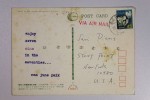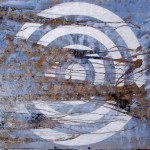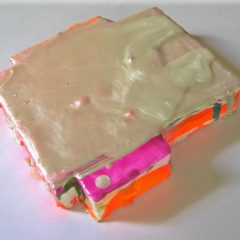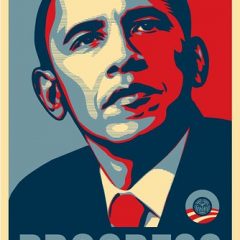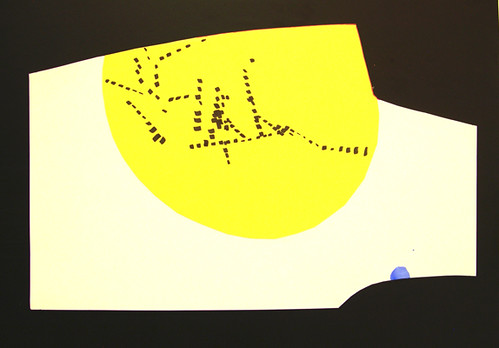
John Tallman, drawing from “Untitled,” 2007. Ink, acrylic, and collage on paper, 19 x 12 inches.
John Tallman‘s drawings are the reason I ran up to New York last month to see Non-Declarative Drawing at the Drawing Center. The group show of 13 artists, curated by Luis Camnitzer, closed Oct. 18. I’m sorry to be so late with this post but thought the show raised issues, and, late or not, I wanted to comment.
Tallman, a former Philadelphia artist now based in Tennessee had an outstanding installation of small colorful drawings and little cast resin tacks on the wall. (See his blog Color Chunks for more of his aesthetic). I did a studio visit with Tallman in 2005 which you can access via artblog’s blogger search button–I’ll put in a link later.) His work was the high point of the show for me. Among the works by the 13 artists there were many things that I’ve seen of late (obsessive word art, sculptural paper, drawings on found envelopes, drawings made with found plastic bags (well maybe I haven’t seen that before), child-like scribbles, plain old graphite drawings and some hard-edged abstraction. But Tallman’s work stood out as something new. The artist’s scatter arrangement with cut paper, cut vinyl, tape and handmade plastic resin tacks was playful, exploratory and unprecious.
In his essay for the show Camnitzer discusses what he means by non-declarative drawing and says, light-heartedly, that the works all are possessed of a seeming dumbness and that they are anti-spectacular and not precious. He says The Drawing Center couldn’t have titled the show Drawings of “apparent stupidity or deceptive dumbness” so thus the title. I have to quibble about the “not precious” label because I found a lot of the work quite precious. But that aside, yes, I’d say “dumb” and “anti-spectacular” are right on target. Humble is also a good word.

Sally Tittmann, “Untitled (#56),” 2007. Pencil on Paper, 20 7/8 x 25 1/2 inches.
Camnitzer positions the non-declarative impulse as almost holy: as giving more to the viewer than a declarative work of art (one that has markers and references to the real world that give clues to meaning). He calls the works silent and congratulates them for renunciating the “self-aggrandizing power of declaration.” Now I have to say that I liked much of the work in the show, in spite of its familiarity –the tropes of id-art that seems to spin off Richard Tuttle. But I have to question how much this art, possessed of a formalism and a degree of hauteur, will speak to an audience of viewers outside art’s inside circle of acolytes who will go the extra mile to figure it out and enjoy it. Maybe that insider circle was the intended audience for the show, I don’t know. I like to think that the Drawing Center, a well-respected institution that publishes catalogs for its shows like the very nice one for this show, has an educational mission that includes a broader audience.
Coded meaning
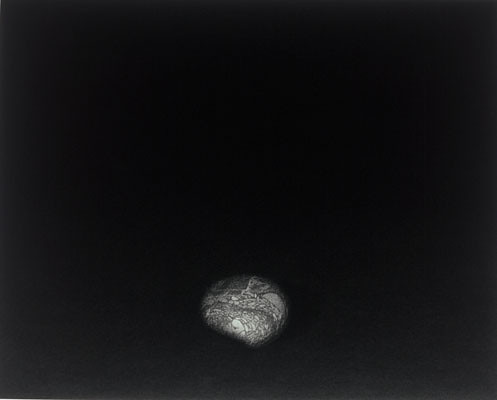
Howard Rosenthal, “Rock 18,” 2003. Charcoal and pastel on paper, 24 x 30 inches.
I want to compare the works’ secret meanings to those commercials and billboard of late that show Abraham Lincoln and a groundhog, both looking forlorn, with the tag line “They miss you” and no product name anywhere. Mildly annoying because they are so coy and un-revealing, the ads are stupid and dumb. Then, when their secret product name was brought forth recently (a sleeping pill) I said no wonder I hated these ads and didn’t understand them — they’re not for me. I don’t need a sleeping pill. The ads’ dumbness and id-channeling worked for some intended audience (doctors? those who know about and think about sleep alot?) but it didn’t work for me.
Like those ads, the work in this show is not only dumb (silent) but difficult. And experiencing the exhibit as a whole is like hitting one high hurdle after another. You could look at the hurdle, admire its making and then, if you weren’t in the mood to tackle the challenge, pass on to the next without attempting a jump. In other words, the art’s formal properties were all admirable but because they are difficult and chilly and non-communicative, a viewer needs to calculate whether the art is for them and thus worth pondering. And while I worked at it and enjoyed myself, this was not a show for someone with a casual interest in art.
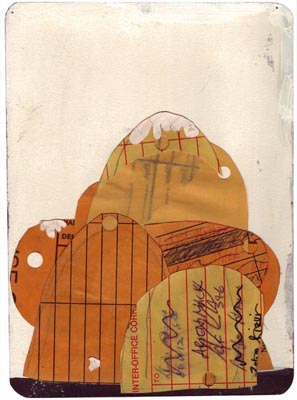
I happen to like declarative art and non-declarative art and lots of what’s in between. And really, most art lies in-between, joining factors that mean something in the real world to factors that ride the subliminal, the dreamy, the non-stated. One of art’s jobs is to communicate, and all the works in this show communicate something. Whether or not they want to, they express pleasure in the making of art, and they express thirteen minds working on issues. What those issues are is not stated obviously because the works hold back. But there is whimsy (inter-office envelopes cut into Guston-esque “hoodies”) and love of materials and process (paper sculptures that are channeling clay and metal).
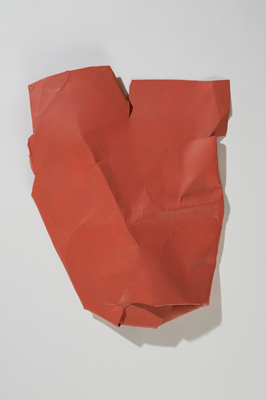
Prajakti Jayavant, “Untitled no. 58,” 2007. Acrylic on paper, 16 1/2 x 12 1/2 x 2 inches.
We live in a stridently declarative culture. We’re awash in ads and messages. This art is like a mini-oasis, a way station on the road, an eyewash after visual overload. While it’s great to have an oasis, it would be nice for art to take back the road and lead instead of providing escapes.
Art is not going to save the world but it should declare itself as an alternative path. That’s not asking too much, is it?
More photos at flickr.
Non-Declarative Art: Selections Fall 2007
Susan Goethel Campbell, Gianna Commito, Michael Diaz, Jeff Feld, Sabine Finkenauer, Prajakti Jayavant, Steven Lowery, Howard Rosenthal, Jay Sheldon, Jered Sprecher, John Tallman, Sally Tittmann, and Gregor Wright
September 14 – October 18, 2007


